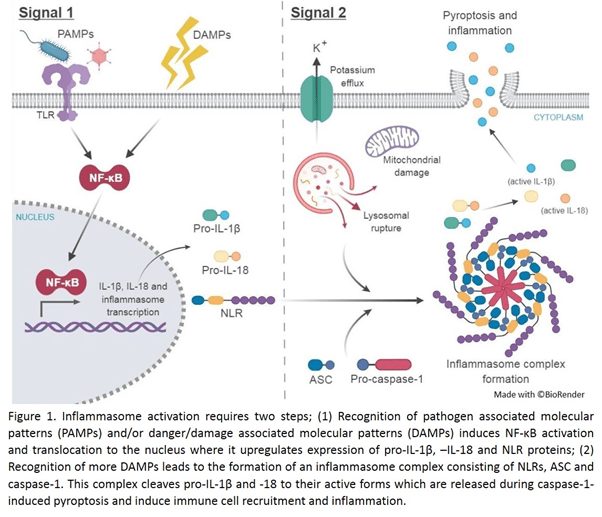Inflammasomes by Katherine Edwards

Katherine Edwards
Inflammasomes: What are they and why should you care about them?
The body’s immune system is responsible for fighting off infection and disease, healing wounds and ensuring homeostasis is restored after danger/damage is eliminated. There are two components that comprise the immune system; innate immunity and adaptive immunity.
The adaptive arm of immunity includes memory responses, such as antibody production, as well as more tailored approaches to combating challenges. Adaptive immunity, however, takes time to ‘switch on’ as it requires instructions. This is where the innate arm of immunity comes to the rescue and kick-starts the appropriate immune response.
Innate immunity is the body’s first line of defence against the external environment. Innate immune cells recognise danger or damage then instruct other cells, including the adaptive immune cells, appropriately to restore homeostasis. Myeloid cells are innate immune cells such as monocytes, macrophages and eosinophils, just to name a few. These cells have the capability to activate a very important protein complex, the inflammasome, which is capable of inducing inflammation and repair.
“What is an inflammasome?”, I hear you ask. Inflammasomes and the inactive cytokines interleukin (IL)-1β and -18 are produced when myeloid cells sense danger/damage, this is termed ‘signal 1’ (Figure 1). Inflammasomes do not become active until stimulated by a second signal, i.e. ‘signal 2’. Upon signal 2 stimulation they form big complexes with caspases, which become active within this complex and proteolytically cleave inactive IL-1β and IL-18 so they become bioactive.
Caspase-1 also induces pyroptosis (osmotic swelling of the cell causing membrane rupture) which allows for the release of IL-1β and IL-18 into the extracellular space. Here these cytokines can signal to neighbouring cells that help is needed fast and even the recruitment of other immune cells – many hands make light work!

So why should we conduct research into inflammasomes? How will this research affect us?
There are many reasons why scientists all over the world are investigating inflammasomes and its impact during diseases and infection.
This is my reason:
Klebsiella pneumoniae (Kp) is a highly antibiotic-resistant pathogen that primarily infects immunocompromised individuals and is capable of causing a wide variety of infections such as pneumonia and urinary tract infections. During infection Kp is phagocytosed by macrophages, an innate immune cell, where it is able to escape death by preventing phagosome maturation. While it lives happily within macrophages it is hidden from other immune cells preventing its clearance.
The World Health Organisation have listed Kp as one of their priority pathogens meaning there is a critical need for new antibiotics to treat infected patients as we will soon run out of antibiotics effective at eliminating this pathogen (1). A greater understanding of how this pathogen evades the immune system is essential to the development of novel therapies and this is where my research comes into play.
Kp has been demonstrated to induce inflammasome activation, but which inflammasome(s) and whether they are vital for the clearance of this pathogen is still unknown. By using various mouse models, which do not express various components of the inflammasome pathways, I have investigated the survival of bacteria in the presence/absence of inflammasome machinery and whether the bacterium induces activation of various inflammasomes as well as the production of active IL-1β. This research will add to the existing knowledge of how Kp manipulates the immune system for its survival and hopefully lead to the development of more specific and effective treatments for Kp-infected patients.
So why should you care about inflammasomes? By investigating the effects of inflammasomes during infection and disease we will improve our understanding of their impact on the pathogenesis and progression of infection and disease, eventually leading to better therapies.
- Kahlmeter G, Singh N. GLOBAL PRIORITY LIST OF ANTIBIOTIC-RESISTANT BACTERIA TO GUIDE RESEARCH, DISCOVERY, AND DEVELOPMENT OF NEW ANTIBIOTICS. [cited 2018 Jun 7]; Available from: https://www.who.int/medicines/publications/WHO-PPL-Short_Summary_25Feb-ET_NM_WHO.pdf?ua=1

